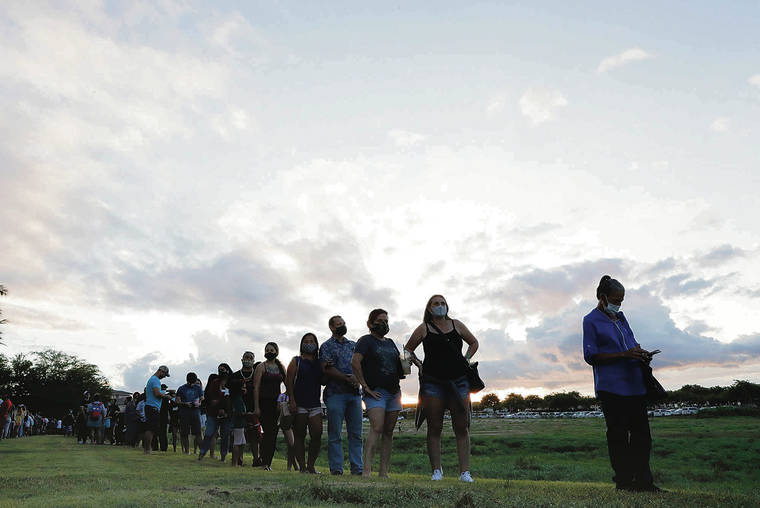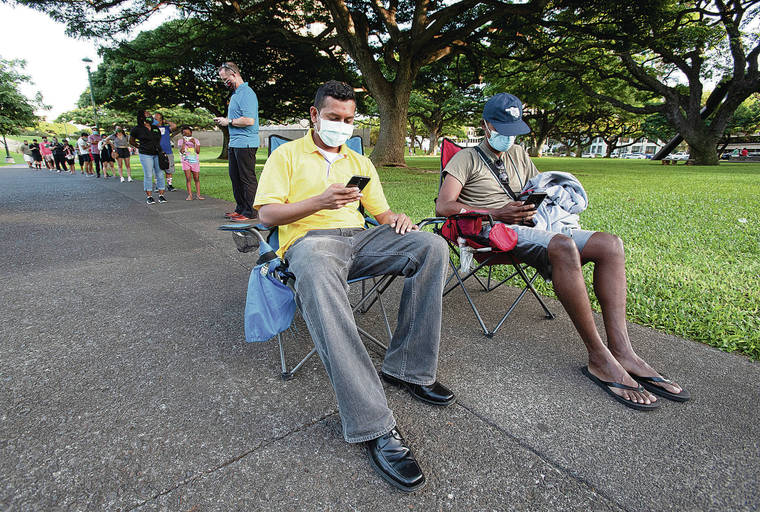Long Election Day voter lines lead to complaints

JAMM AQUINO/JAQUINO@STARADVERTISER.COM
Voters waited in line — some for up to six hours — outside Kapolei Hale on Tuesday.

CINDY ELLEN RUSSELL / CRUSSELL@STARADVERTISER.COM
Harish Rao and his friend Jay brought chairs for their wait in line to vote at Honolulu Hale on Tuesday.


Honolulu election officials said they anticipated more Oahu residents would show up on Election Day to vote at one of the two designated voter services centers on the island, just not 4,520 of them during that 12-hour span.
“We just got bombed,” City Clerk Glen Takahashi said.
City Elections Administrator Rex Quidilla said his office had increased staffing and took other measures in preparation of a surge.
“We understood that there was a great possibility that we would have seen an increase on the last day,” Quidilla said. “But to the degree of which we saw (Tuesday), that was a lot more than we ever anticipated.”
That’s not acceptable to Common Cause Hawaii Executive Director Sandy Ma, who had warned elections officials since before the Aug. 8 primary that the eight voting sites across the state, including the two on Oahu, would be inadequate and that other policies established by the counties and state weren’t going to work either.
“It was foreseeable,” Ma said. “People were saying that this is the most important election of our lifetime.”
Don't miss out on what's happening!
Stay in touch with breaking news, as it happens, conveniently in your email inbox. It's FREE!
Besides that, the U.S. Postal Service issued cards warning voters that voter delivery might take longer than usual, Ma said. “We have been hearing national messaging wrongfully calling into doubt (the vote by mail process), which would send people to voter service centers. And this is the first time we’re doing this, all by mail.”
Common Cause Hawaii led a coalition of 17 community advocacy groups in May that called on the state and counties to put in place more voter service centers and drop-off box sites, describing the situation as a violation of the Hawaii Constitution. The groups noted the extraordinary circumstances that the COVID-19 pandemic had added to the situation. On Oahu, the city upped the number of drop-off box sites to 12 from eight, but kept the voter service center count at two.
The Department of the Attorney General wrote back stating that the eight voting sites was acceptable, noting that eight were made available when the law passed by the Legislature required only that four be set up statewide.
Ma said that when the lines started to form and lengthen, elections officials should have given better instructions that those with ballots already filled out and in hand could simply place them in the drop boxes. “There were people in the back of the line who just wanted to drop off their ballots and they didn’t understand that they could go up front, so they were just standing back there.”
State Chief Elections Officer Scott Nago, tasked with overseeing the elections process across the islands, told television reporters that he also felt the long lines were unacceptable and that he, personally, would not have stood in line for four hours. He said he and the city clerks would need to discuss the situation.
State law says the centers are supposed to close at 7 p.m. but that anyone in line by that time is to be allowed to vote. Hundreds waited at Honolulu Hale and Kapolei Hale, where the line snaked several times along one side of the building. Some stood for as long as four hours in Honolulu, six in Kapolei.
Honolulu Hale finally locked its doors at 10:30 p.m. while the last person was able to vote at Kapolei around 11:30 p.m. Delays were experienced by voters in line on other islands as well, but none approached the wait times on Oahu.
The long lines didn’t just pose an inconvenience for those standing in them. A state law bars the state from releasing any voting results until the last person in line at 7 has voted, meaning everyone in the state was kept in suspense about the outcome of all the races, including those for Honolulu and Hawaii County mayor and prosecutor, for more than four hours.
Takahashi said the two centers, combined, were averaging about 1,000 people in the 13 previous days they were open. “We were going along fairly comfortably until the last day, when we got bombed,” he said.
Compounding the situation was that 1,805 previously unregistered voters decided to show up on the last possible day to take advantage of the fairly new “same-day registration” law, as did an additional 769 registered voters requiring change in address adjustments. Those types of activities take longer than those involving people who just want to go vote, Takahashi said.
The city is open to the possibility of adding more voter service centers if geographic accessibility is a concern, and Takahashi said he expects the discussion to take place with state lawmakers and the state Office of Elections. But he noted that the service centers were spawned by this year’s move to vote by mail and aimed at shifting voting away from in-person voting. The hundreds of traditional polling precincts that were set up in cafeterias and community centers in years past were ditched, Takahashi said, but the service centers were designed to do more than just accommodate voters on election day because they were accepting votes throughout the island.
Opening additional voter sites in hopes that they would “load balance” across them without regard to geographic need wouldn’t necessarily mean one of those sites couldn’t get flooded, he said.
If the concern being addressed is not delaying the release of election results, the law could be changed so that results are released at 7 p.m. or whenever the doors are supposed to close instead of when the last person is done voting, he said.
The purpose of the vote by mail policy, adopted by the Legislature in 2019, “was to change voter patterns and the way that people vote,” Takahashi said.
“Now if we added on multiple sites (to address) better geographic accessibility for different parts of the island, that’s a different story,” he said.
Another way of reducing long lines is to revert back to using paper ballots for in-person voting because it tends to be quicker than using electronic voting machines, Takahashi said.
Takahashi said the two walk-in centers on Oahu took in 17,195 ballots over the 14 days, only a fraction of the record total 372,307 votes, which blew away the previous record of 308,443 in 2006. Of the total, about 17% to 18% were placed in drop boxes, including an estimated 12,000 ballots on general election day, he said.
On Tuesday, and several days preceding election day, Common Cause volunteers distributed water and snacks for those waiting for a lengthy period at both Honolulu and Kapolei. When the lines really started to stretch in Kapolei, the volunteers handed out pizza, Ma said.
“We’re in the middle of a pandemic,” Ma said. “With the economic difficulties, people have lost their jobs and had to move.”
So elections officials should have anticipated a spike in address change requests, especially because ballots cannot be forwarded by U.S. mail, Ma said.
“We want people to vote, we want elections officials to be successful because this helps democracy,” she said. “We’re not here to point the finger of blame. We want to uplift everyone.”
Mayor Kirk Caldwell said the long lines were a good sign that the democratic process was working. “That’s a good thing that more people voted than we could handle in the last day of voting.”




